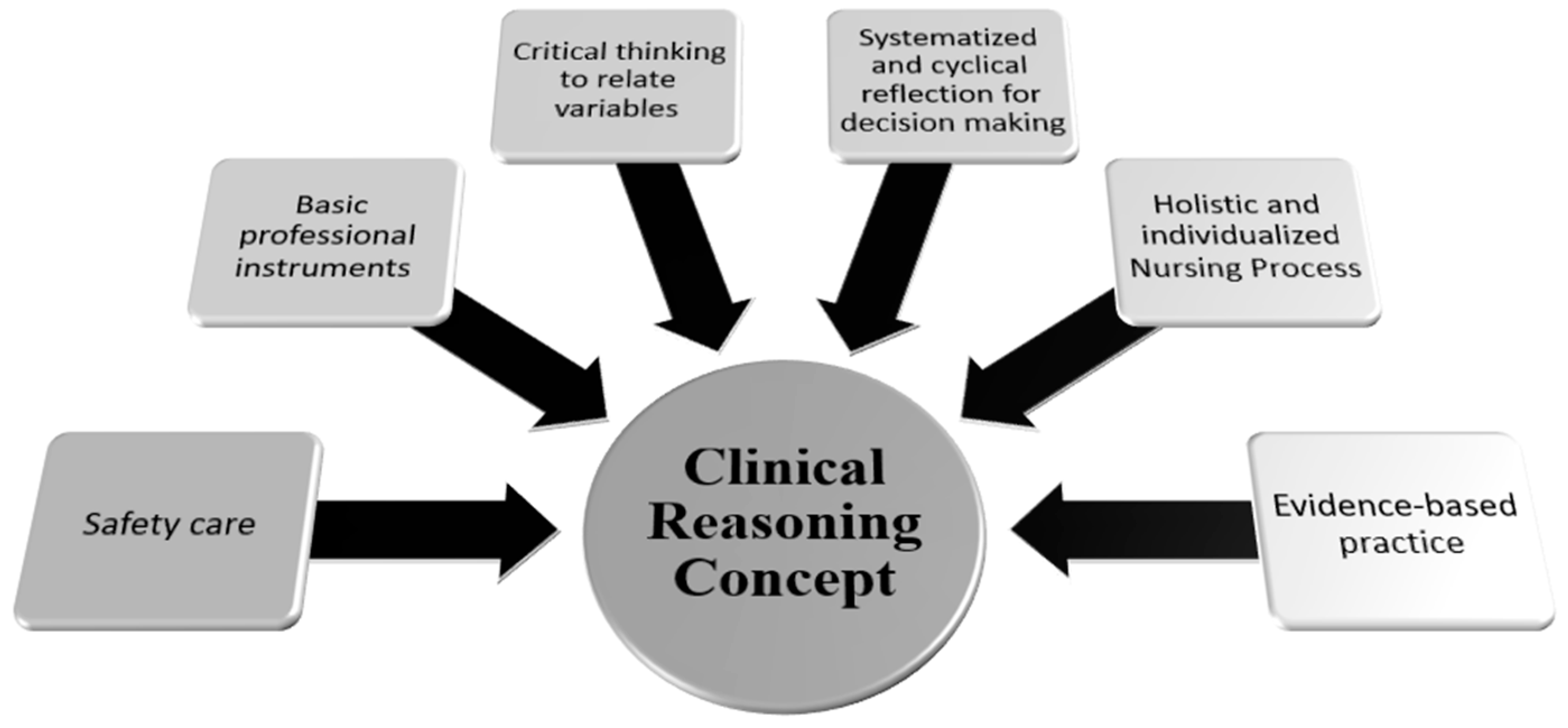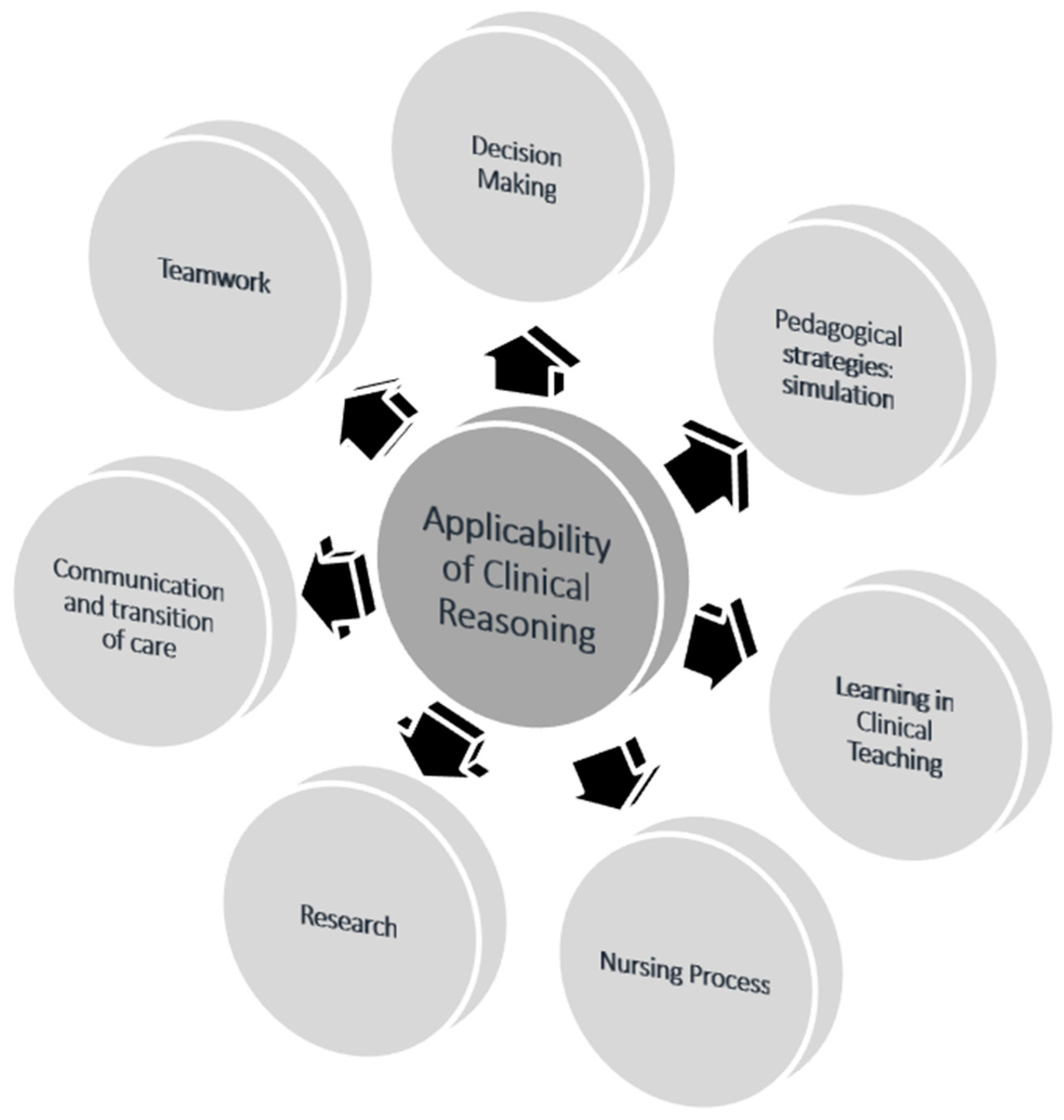Teaching and Learning Clinical Reasoning in Nursing Education: A Student Training Course
Abstract
1. Introduction
1.1. The Conceptualization and the Potential of Clinical Reasoning in Nursing and Midwifery Education
1.2. Pedagogic Considerations in the Teaching/Learning Process of Clinical Reasoning
2. Materials and Methods
2.1. Study Design and Participant Recruitment
2.2. Data Collection
- (i)
- The students were randomly divided into six groups of eight.
- (ii)
- Each group had a facilitator who encouraged reflection on clinical reasoning based on two questions asked at two different times by the rotational dynamic of this methodology. The questions were: (1) What do you understand by clinical reasoning? and (2) In what situations have you applied or developed clinical reasoning? The groups discussed and reflected on the two questions in two separate 20 min sessions.
- (iii)
- The students organized the answers to the two questions in a graphic structure resembling a mind map created on paper using the materials provided by the facilitators at each table.
- (iv)
- The students shared the responses to the questions orally from each small group to the large group, encouraging discussion and allowing the facilitators to summarize the students’ main ideas. Killam et al. reinforce that general feedback and discussion through a large group help the facilitator to comment constructively on student contributions [33].
2.3. Data Analysis
3. Results
4. Discussion
Limitations
5. Conclusions
Author Contributions
Funding
Institutional Review Board Statement
Informed Consent Statement
Data Availability Statement
Acknowledgments
Conflicts of Interest
References
- Menezes, S.; Corrêa, C.; Silva, R.; Cruz, D. Clinical Reasoning in Undergraduate Nursing Education: A Scoping Review. J. Sch. Nurs. Univ. São Paulo 2015, 49, 1032–1039. [Google Scholar] [CrossRef]
- Tyo, M.B.; McCurry, M.K. An Integrative Review of Clinical Reasoning Teaching Strategies and Outcome Evaluation in Nursing Education. Nurs. Educ. Perspect. 2019, 40, 11–17. [Google Scholar] [CrossRef]
- Sudacka, M.; Adler, M.; Durning, S.J.; Edelbring, S.; Frankowska, A.; Hartmann, D.; Hege, I.; Huwendiek, S.; Sobočan, M.; Thiessen, N.; et al. Why is it so difficult to implement a longitudinal clinical reasoning curriculum? A multicenter interview study on the barriers perceived by European health professions educators. BMC Med. Educ. 2021, 21, 575. [Google Scholar] [CrossRef]
- Pađen, L.; Pajnič, M.; Vettorazzi, R.; Pérez-Perdomo, A.; Stefaniak, M.; Claes, N.; Franco, H.; Vandervoort, A.; Ravljen, M. “Learning a Way of Thinking”—World Café on Clinical Reasoning in Nursing and Midwifery Education and Practice across Five European Union Countries. Healthcare 2023, 11, 2969. [Google Scholar] [CrossRef]
- Simmons, B.; Lanuza, D.; Fonteyn, M.; Hicks, F.; Holm, K. Reasoning in experienced nurses. West J. Nurs. Res. 2003, 25, 701–719. [Google Scholar] [CrossRef]
- Simmons, B. Clinical reasoning: Concept analysis. J. Adv. Nurs. 2010, 66, 1151–1158. [Google Scholar] [CrossRef]
- Mohammadi-Shahboulaghi, F.; Khankeh, H.; HosseinZadeh, T. Clinical reasoning in nursing students: A concept analysis. Nurs. Forum 2021, 56, 1008–1014. [Google Scholar] [CrossRef]
- Hong, S.; Lee, J.; Jang, Y.; Lee, Y. A Cross-Sectional Study: What Contributes to Nursing Students’ Clinical Reasoning Competence? Int. J. Environ. Res. Public Health 2021, 18, 6833. [Google Scholar] [CrossRef]
- Kuiper, R.; O’Donnell, S.; Pesut, D.; Turrise, S. The Essentials of Clinical Reasoning for Nurses: Using the Outcome-Present State Test Model for Reflective Practice; Sigma Theta Tau International: Indianapolis, IN, USA, 2017. [Google Scholar]
- Alfaro-Lefevre, R. Critical Thinking, Clinical Reasoning, and Clinical Judgment: A Practical Approach, 7th ed.; Elsevier Health Sciences: St. Louis, MO, USA, 2020. [Google Scholar]
- Higgs, J.; Jensen, G.; Loftus, S.; Christensen, N. Clinical Reasoning in the Health Professions, 4th ed.; Elsevier Health Sciences: Edinburgh, Scotland, UK, 2018. [Google Scholar]
- Gordon, D.; Rencic, J.; Lang, V.; Thomas, A.; Young, M.; Durning, S. Advancing the assessment of clinical reasoning across the health professions: Definitional and methodologic recommendations. Perspect. Med. Educ. 2022, 11, 108–114. [Google Scholar] [CrossRef]
- Fontenot, J.; Leigh, G.; Watson, C.; Stueben, F.; Arceneaux, S.; Johnson, S.; Romain, A. Teaching Prelicensure Nursing Students Reasoning in Clinical Experiences: A Pilot Study. J. Nurs. Educ. 2023, 62, 467–470. [Google Scholar] [CrossRef]
- Tanner, C. Thinking like a nurse: A research-based model of clinical judgment in nursing. J. Nurs. Educ. 2006, 45, 204–211. [Google Scholar] [CrossRef]
- Benner, P.; Tanner, C.; Chelsea, C. Expertise in Nursing Practice, Caring, Clinical Judgment and Ethics, 2nd ed.; Springer Publishing Company: New York, NY, USA, 2009. [Google Scholar]
- Griffits, S.; Hines, S.; Moloney, C.; Ralph, N. Characteristic and process of clinical reasoning in nurses and factors related to its use: A scoping review. JBI Database Syst. Rev. Implement. Rep. 2017, 15, 2832–2836. [Google Scholar] [CrossRef]
- Parodis, I.; Andersson, L.; Durning, S.; Hege, I.; Knez, J.; Kononowicz, A.; Lidskog, M.; Petreski, T.; Szopa, M.; Edelbring, S. Clinical Reasoning Needs to Be Explicitly Addressed in Health Professions Curricula: Recommendations from a European Consortium. Int. J. Environ. Res. Public Health 2021, 18, 11202. [Google Scholar] [CrossRef]
- Gonzalez, L.; Nielsen, A.; Lasater, K. Developing Students’ Clinical Reasoning Skills: A Faculty Guide. J. Nurs. Educ. 2021, 60, 485–493. [Google Scholar] [CrossRef]
- Cartwright, P.; Bruce, J.; Mclnerney, P. Effects of problem-based learning on nurse competence: A systematic review. J. Nurs. Educ. Pract. 2016, 7, 67–75. [Google Scholar] [CrossRef]
- Ricros, D.; Rivière, E. Analysis of midwifery teachers’ approach to identifying student midwives with poor clinical reasoning skills. Midwifery 2018, 66, 10–16. [Google Scholar] [CrossRef]
- Craft-Blacksheare, M.; Frencher, Y. Using high fidelity simulation to increase nursing students’ clinical postpartum and newborn assessment proficiency: A mixed-methods research study. Nurse Educ. Today 2018, 71, 198–204. [Google Scholar] [CrossRef]
- Lee, H.; Min, H.; Oh, S.-M.; Shim, K. Mobile Technology in Undergraduate Nursing Education: A Systematic Review. Healthc. Inform. Res. 2018, 24, 97–108. [Google Scholar] [CrossRef]
- Watari, T.; Tokuda, Y.; Owada, M.; Onigata, K. The Utility of Virtual Patient Simulations for Clinical Reasoning Education. Int. J. Environ. Res. Public Health 2020, 17, 5325. [Google Scholar] [CrossRef]
- Zhao, X.; Cong, L. Effect of problem and scripting-based learning combining wearable technology on orthopedic operating room nurses’ learning outcomes. Nurse Educ. Today 2019, 73, 13–16. [Google Scholar] [CrossRef]
- Pérez-Perdomo, A.; Zabalegui, A. Teaching Strategies for Developing Clinical Reasoning Skills in Nursing Students: A Systematic Review of Randomised Controlled Trials. Healthcare 2024, 12, 90. [Google Scholar] [CrossRef]
- Boev, C. Next Generation NCLEX: Why Simulation Matters. J. Nurs. Educ. 2023, 62, 285–289. [Google Scholar] [CrossRef]
- Cleland, J.; Gates, L.; Waiter, G.; Ho, V.; Schuwirth, L.; Durning, S. Even a little sleepiness influences neural activation and clinical reasoning in novices. Health Sci. Rep. 2021, 4, e406. [Google Scholar] [CrossRef]
- Liu, G.; Chimowitz, H.; Isbell, L. Affective influences on clinical reasoning and diagnosis: Insights from social psychology and new research opportunities. Gruyer Diagn. 2022, 9, 295–305. [Google Scholar] [CrossRef]
- Schmidt, H.; Mamede, S. How to improve the teaching of clinical reasoning: A narrative review and a proposal. Med. Educ. 2015, 49, 961–973. [Google Scholar] [CrossRef]
- Anakin, M.; Jouart, M.; Timmermans, J.; Pinnock, R. Student experiences of learning clinical reasoning. Clin. Teach. 2019, 17, 52–57. [Google Scholar] [CrossRef]
- Wyngaarden, A.; Leech, R.; Coetzee, I. Challenges nurse educators experience with development of student nurses’ clinical reasoning skills. Nurse Educ. Pract. 2019, 40, 102623. [Google Scholar] [CrossRef]
- Löhr, K.; Weinhardt, M.; Sieber, S. The “World Café” as a Participatory Method for Collecting Qualitative Data. Int. J. Qual. Methods 2020, 19. [Google Scholar] [CrossRef]
- Killam, L.A.; Luctkar-Flude, M.; Tyerman, J. Shaping Social Justice Values Through Inclusive Assessment and Debriefing of eLearning Modules. J. Nurs. Educ. 2024, 63, 48–52. [Google Scholar] [CrossRef]
- Braun, V.; Clarke, V. Using thematic analysis in psychology. Qual. Res. Psychol. 2006, 3, 77–101. [Google Scholar] [CrossRef]
- Parandavar, N.; Rezaee, R.; Mosallanejad, L.; Mosallanejad, Z. Designing a blended training program and its effects on clinical practice and clinical reasoning in midwifery students. J. Educ. Health Promot. 2019, 8, 131. [Google Scholar] [CrossRef]
- Liu, W.-I.; Edwards, H.; Courtney, M. Review of continuing professional education in case management for nurses. Nurse Educ. Today 2009, 29, 488–492. [Google Scholar] [CrossRef]
- Vermeulen, J.; Buyl, R.; D’haenens, F.; Swinnen, E.; Stas, L.; Gucciardo, L.; Fobelets, M. Midwifery students’ satisfaction with perinatal simulation-based training. Women Birth 2021, 34, 554–562. [Google Scholar] [CrossRef]
- Mechtel, M.; Kitt-Lewis, E.; Reaves, C.; Sinacori, B.; O’Brien, T.; Logan, P.; Rimbey, P.; Streiff, K.; Phillips, K. Durable Learning Strategies in Nursing Education: State-of-the-Evidence Review. J. Nurs. Educ. 2024, 63, 24–31. [Google Scholar] [CrossRef]


| Questions | Likert 5 Points Scale | Results n = 43 % (n) | ||||
|---|---|---|---|---|---|---|
| In your opinion, what is the relevance of clinical reasoning in nursing? | From 1 Not very relevant to 5 Highly relevant | 1 0.0% (n = 0) | 2 0.0% (n = 0) | 3 0.0% (n = 0) | 4 30.2% (n = 13) | 5 69.8% (n = 30) |
| Do you agree that the presented model contributes to developing clinical reasoning competence in nursing? | From 1 Totally disagree to 5 Strongly agree | 1 0.0% (n = 0) | 2 0.0% (n = 0) | 3 0.0% (n = 0) | 4 27.9% (n = 12) | 5 72.1% (n = 31) |
| What is your satisfaction with the STC in clinical reasoning? | From 1 Not at all satisfied to 5 Extremely satisfied | 1 0.0% (n = 0) | 2 0.0% (n = 0) | 3 4.7% (n = 2) | 4 46.5% (n = 20) | 5 48.8% (n = 21) |
| In your opinion, what was the effectiveness of the training STC in clinical reasoning? | From 1 Not very effective to 5 Highly effective | 1 0.0% (n = 0) | 2 0.0% (n = 0) | 3 7.0% (n = 3) | 4 51.2% (n = 22) | 5 41.9% (n = 18) |
| Do you agree that the STC in clinical reasoning brought you new knowledge that you can apply in your clinical learning? | From 1 Totally disagree to 5 Strongly agree | 1 0.0% (n = 0) | 2 0.0% (n = 0) | 3 0.0% (n = 0) | 4 37.2% (n = 16) | 5 62.8% (n = 27) |
| What is your overall evaluation of the STC in clinical reasoning? | From 1 Very weak to 5 Very good | 1 2.3% (n = 1) | 2 0.0% (n = 0) | 3 2.3% (n = 1) | 4 39.5% (n = 17) | 5 55.8% (n = 24) |
Disclaimer/Publisher’s Note: The statements, opinions and data contained in all publications are solely those of the individual author(s) and contributor(s) and not of MDPI and/or the editor(s). MDPI and/or the editor(s) disclaim responsibility for any injury to people or property resulting from any ideas, methods, instructions or products referred to in the content. |
© 2024 by the authors. Licensee MDPI, Basel, Switzerland. This article is an open access article distributed under the terms and conditions of the Creative Commons Attribution (CC BY) license (https://creativecommons.org/licenses/by/4.0/).
Share and Cite
Leal, P.; Poeira, A.; Mendes, D.A.; Batalha, N.; Franco, H.; Nunes, L.; Marques, F.; Pađen, L.; Stefaniak, M.; Pérez-Perdomo, A.; et al. Teaching and Learning Clinical Reasoning in Nursing Education: A Student Training Course. Healthcare 2024, 12, 1219. https://doi.org/10.3390/healthcare12121219
Leal P, Poeira A, Mendes DA, Batalha N, Franco H, Nunes L, Marques F, Pađen L, Stefaniak M, Pérez-Perdomo A, et al. Teaching and Learning Clinical Reasoning in Nursing Education: A Student Training Course. Healthcare. 2024; 12(12):1219. https://doi.org/10.3390/healthcare12121219
Chicago/Turabian StyleLeal, Paula, Ana Poeira, Diana Arvelos Mendes, Nara Batalha, Hugo Franco, Lucília Nunes, Fernanda Marques, Ljubiša Pađen, Małgorzata Stefaniak, Ana Pérez-Perdomo, and et al. 2024. "Teaching and Learning Clinical Reasoning in Nursing Education: A Student Training Course" Healthcare 12, no. 12: 1219. https://doi.org/10.3390/healthcare12121219
APA StyleLeal, P., Poeira, A., Mendes, D. A., Batalha, N., Franco, H., Nunes, L., Marques, F., Pađen, L., Stefaniak, M., Pérez-Perdomo, A., Bangels, L., Lemmens, K., & Amaral, G. (2024). Teaching and Learning Clinical Reasoning in Nursing Education: A Student Training Course. Healthcare, 12(12), 1219. https://doi.org/10.3390/healthcare12121219









